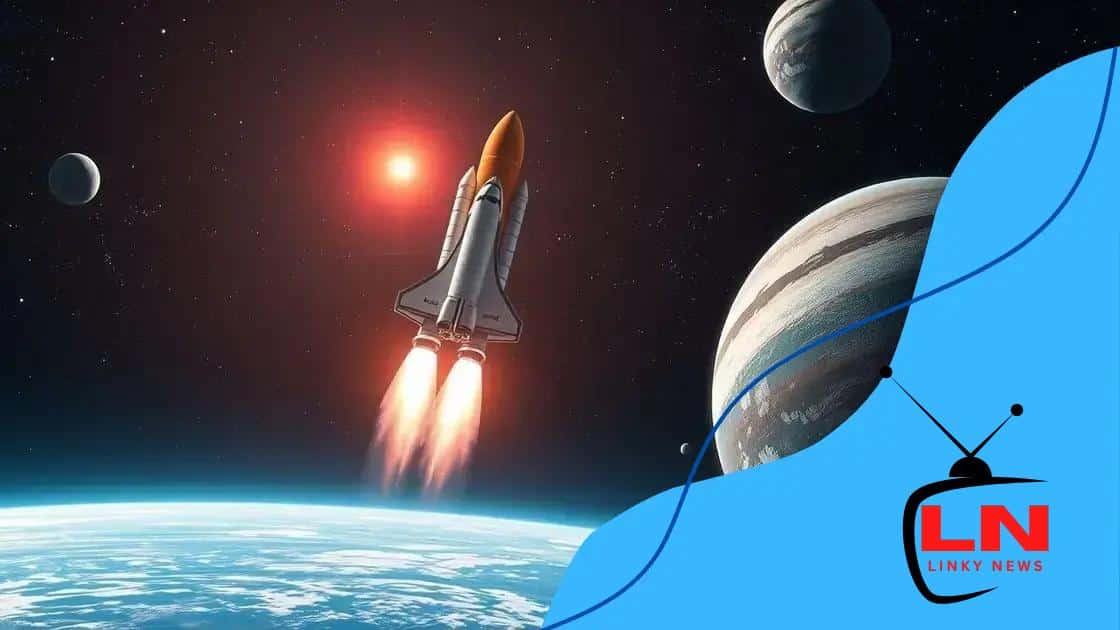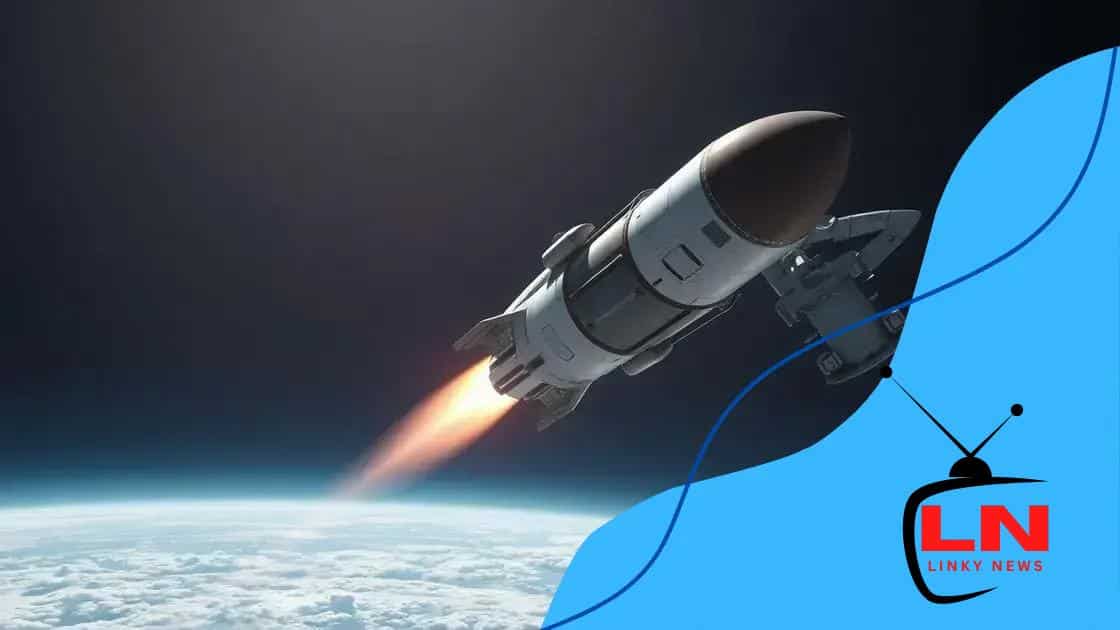Space exploration milestones that changed our world

Space exploration milestones include returning to the Moon, sending humans to Mars, and advancing technology through international collaboration, significantly expanding our understanding of the universe.
Space exploration milestones have not only expanded our understanding of the universe, but they also impact our daily lives more than we realize. Have you ever wondered how these groundbreaking events shape technology and society today?
The dawn of human spaceflight
The dawn of human spaceflight marked a significant turning point in our quest to explore the universe. This era began with a series of daring missions that showcased the boldness of human curiosity and innovation. Early attempts involved overcoming numerous challenges, including technical failures and ensuring the safety of astronauts.
The first milestone was the launch of Vostok 1 on April 12, 1961, carrying Yuri Gagarin, the first human to orbit Earth. This achievement was monumental and demonstrated that humans could survive in the harsh conditions of space.
The Space Race
The race between the United States and the Soviet Union led to several critical developments in spaceflight technology. The national pride associated with these missions fueled advancements in rocket design and safety protocols.
- Project Mercury by NASA aimed to achieve human spaceflight.
- Gemini missions tested techniques for long-duration flights.
- Apollo program prepared for lunar landings.
Each mission built upon the knowledge gained from previous flights, significantly contributing to our understanding of space travel.
As astronauts ventured into space, they faced many risks, from exposure to radiation to the effects of microgravity on the human body. The lessons learned from these early missions were crucial in shaping the future of space exploration.
Legacy of Early Spaceflight
The impact of these early endeavors is still felt today. The breakthroughs achieved during the 1960s laid the groundwork for modern space exploration. They helped establish safety measures and technological innovations that continue to benefit astronauts and scientists alike.
Moreover, these missions sparked global interest in space, leading to an era of collaboration among nations. International partnerships like the International Space Station (ISS) are a testament to the legacy of early human spaceflight. As we look to the future, the spirit of exploration initiated in the 20th century will inspire generations.
Key missions that expanded our knowledge
Key missions that expanded our knowledge of space have reshaped our understanding of the universe. These missions have not only achieved remarkable technical feats but have also pushed the boundaries of human potential.
One of the most notable missions was Apollo 11, which landed the first humans on the Moon in 1969. Neil Armstrong and Buzz Aldrin took those historic steps, marking mankind’s impressive achievement and opening a new chapter in space exploration.
Recent Milestones
Several missions followed, contributing immensely to our knowledge. The Hubble Space Telescope revolutionized astronomy by providing clear images of distant galaxies. Its discoveries have changed our perspective on space and our place within it.
- The Voyager missions gave us incredible insights into the outer planets, including detailed data about Jupiter and Saturn.
- The Mars Rover missions have explored the Martian surface, analyzing soil and searching for signs of past life.
- New Horizons captured breathtaking images of Pluto, revealing a complex world previously shrouded in mystery.
These missions demonstrated how technology could unlock the secrets of the cosmos. As discoveries piled up, they also inspired future generations to reach for the stars.
International Efforts
Global cooperation has played a vital role in advancing space knowledge. The International Space Station (ISS) serves as a collaborative platform, hosting experiments that let scientists study the effects of microgravity.
Through these joint efforts, countries can share resources, knowledge, and innovations. Every mission adds more to the puzzle of our universe, showcasing how working together leads to extraordinary outcomes.
Ultimately, these key missions serve as a reminder of the human spirit’s unyielding desire to explore and understand the unknown.
Technological advancements in space exploration

Technological advancements in space exploration have dramatically changed how we understand our universe. These innovations have made missions safer, more efficient, and capable of achieving greater discoveries.
One key advancement is the development of reusable rockets. Companies like SpaceX have pioneered technologies that allow rockets to land and be reused, significantly reducing costs and increasing the frequency of missions.
Innovations in Spacecraft Design
Modern spacecraft come equipped with advanced technologies that help conduct research and operate in hostile environments. For instance, the Curiosity Rover uses sophisticated sensors to analyze Mars’s surface, sending valuable data back to Earth.
- Responsive AI systems help with navigation and real-time decision-making.
- Advanced materials are used for heat resistance during reentry.
- Solar panels and batteries provide energy for long missions.
These innovations enhance our ability to explore distant worlds and gather crucial information efficiently.
Communication Technologies
Effective communication between Earth and space missions is vital for their success. Advances in communication technology have led to clearer signals and faster data transmission. NASA’s Deep Space Network allows for communication with spacecraft millions of miles away.
Furthermore, satellite technology has become essential in sending back images and live data. This real-time connection enables scientists to monitor missions closely and respond to challenges as they arise.
As space exploration continues to advance, innovations will likely focus on further enhancing efficiency and safety. These technological strides not only make missions more successful but also push the boundaries of what humanity can achieve in space.
The role of international collaboration
The role of international collaboration in space exploration has become increasingly important as nations recognize the need to work together. By combining resources, knowledge, and technology, countries can achieve remarkable goals that would be difficult to reach alone.
One of the prime examples of effective collaboration is the International Space Station (ISS). This unique platform allows astronauts from various countries to live and work together in space. It serves as a laboratory where scientific experiments are conducted, addressing global challenges.
Benefits of Collaboration
Collaborative missions lead to several benefits, such as:
- Pooling financial resources, making space exploration more affordable.
- Sharing knowledge and expertise to develop better technologies.
- Creating a sense of unity among nations, promoting peaceful relationships.
Such partnerships not only enhance the quality of research but also inspire global citizens to look toward the stars together.
Notable Collaborative Missions
Several significant missions highlight successful international efforts. For instance, the joint Mars exploration efforts involve multiple space agencies working together on rover missions. NASA, ESA, and other organizations exchange data and find new ways to explore Mars.
Furthermore, satellite launches often involve coordination between different countries’ space agencies. Such teamwork has resulted in advanced technology for monitoring climate change, natural disasters, and communication systems.
The continuous exchange of ideas and resources amplifies the possibilities for future missions. As we look forward, the importance of international collaboration in space exploration will only continue to grow. By joining forces, humanity can achieve goals that were once thought to be impossible.
Future milestones in space exploration
Future milestones in space exploration promise to take us beyond the boundaries of our current understanding. As technology advances, new missions and objectives are being set, aiming to explore deep space and other celestial bodies.
One of the most anticipated goals is the return to the Moon through NASA’s Artemis program. This initiative aims to land the first woman and the next man on the lunar surface by the mid-2020s, which will pave the way for sustainable exploration.
Mars Missions
Exploring Mars remains a priority for many space agencies. Plans to send humans to Mars within the next two decades are being developed. This will involve extensive research to ensure the safety and well-being of astronauts during the long journey and the stay on the Martian surface.
- Establishing a base camp on Mars for long-term habitation.
- Conducting in-situ resource utilization, such as extracting water from the soil.
- Deploying advanced robotics to assist with the construction of habitats.
Such developments would not only expand our footprint in space but enhance our skills for future exploration.
Exploration of the Outer Solar System
Space agencies are also gearing up to explore the outer solar system. Upcoming missions include sending spacecraft to the far reaches of our solar system. The Europa Clipper will investigate Jupiter’s moon Europa, which is believed to have a subsurface ocean.
Additionally, missions to study Saturn’s moon Titan will analyze its atmosphere and surface conditions. These missions could reveal vital information about the potential for life beyond Earth.
The goals set for these future milestones highlight humanity’s enduring curiosity and desire to explore the cosmos. With international collaboration and technological innovation, the next chapters in space exploration can be truly groundbreaking.
FAQ – Frequently Asked Questions about Space Exploration
What are the main goals of the Artemis program?
The Artemis program aims to return humans to the Moon, including the first woman and the next man, and establish a sustainable presence by the mid-2020s.
How does international collaboration benefit space missions?
International collaboration pools resources, knowledge, and expertise, making missions more affordable and enhancing scientific discoveries.
What technological advancements have been made in space exploration?
Recent advancements include reusable rockets, sophisticated spacecraft with AI, and improved communication systems for real-time data transmission.
What are some future missions planned for Mars?
Future missions focus on sending humans to Mars, establishing a base camp, conducting in-situ resource utilization, and searching for signs of past life.





